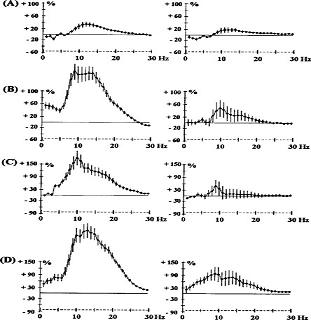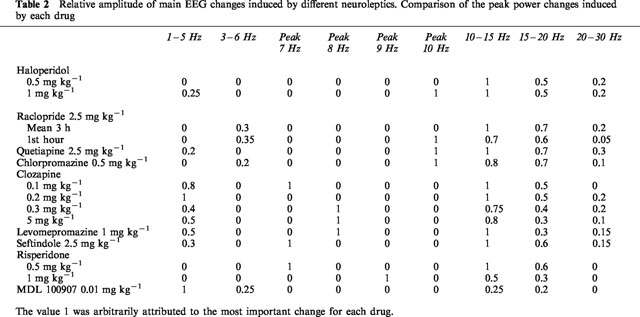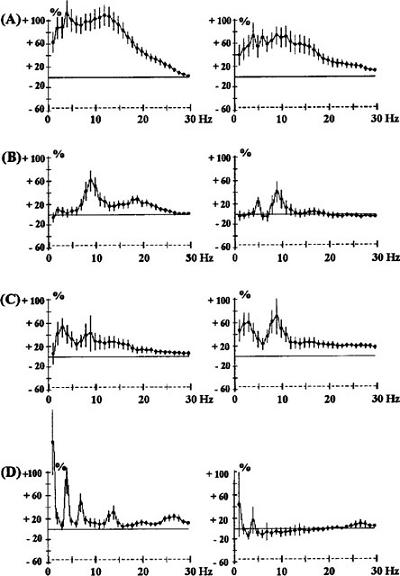Modafinil vs. Clozaril
I'm researching modafinil for my last post, and bam-- I see this thing. How is no one talking about this article? Does no one read anymore?
A short intro to EEGs and antipsychotics.
Generally, antipsychotics increase power across all frequencies, but each drug (or receptor system) is associated with a specific frequency's power increase. Additionally, antipsychotics' effects are region specific: here, the prefrontal cortex gets the majority of the effect.

Effects of haloperidol 0.5 mg kg-1 s.c. (A) and 1 mg kg-1 s.c. (B); chlorpromazine 0.5 mg kg-1 i.p. (C) and quetiapine 2.5 mg kg-1 s.c. (D) on EEG spectral power in rats. Panels on the left show data from prefrontal cortex, panels on the right show data from sensorimotor cortex.
Everything is higher (i.e. above the line), but see how each drug or dose changes which frequency sees the most increase in power? So now you can make a comparison table:

Summarizing:
D2 blockers (haldol, racloperide): increase in 10-15Hz power band (lesser in 15-20Hz)
Pure 5HT2A blockers (MDL100907): increases 2 Hz power band
High 5HT2/D2 ratios (Risperdal, sertindole): peak synchronization at 7-10 Hz.
In other words, mixing receptors gets you a mixed effect on EEG.
Additionally, drugs with high alpha-1 blockade (Clozapine, chlorpromazine, quetiapine) increase in 8-10 Hz power band.
You would guess that mixing an antipsychotic with apomorphine (a dopamine agonist) might decrease these effects, and mostly this would be right. There seems to be more effect on the sensorimotor cortex, but this isn't today's message.
What do you think would happen if you mixed Provigil and racloperide (D2 blocker) or clozapine? With racloperide, Provigil increased the power in the 10Hz band in both prefrontal and sensorimotor cortex-- a lot.
But apomorphine added to clozapine had no effect-- and Provigil added to clozapine decreased-- and at high doses almost totally extinguished-- the effect. This is the opposite of what happens in a pure D2 blocker!

Effects of the co-administration of clozapine (CLZ, A) 0.2 mg kg-1 s.c. and modafinil (MOD) 62.5 mg kg-1 i.p. (B), 125 mg kg-1 i.p. (C) or 250 mg kg-1 i.p. (D) in rats. The ordinate represents the percentage change in EEG power. Vertical bars for each Hz show 95% confidence intervals. Panels on the left show data from prefrontal cortex, panels on the right show data from sensorimotor cortex.
The likely explanation is alpha-1 blockade. Clozapine is a potent alpha-1 blocker. The wakefulness promoting, and EEG, effects of Provigil, which has no affinity for adrenergic receptors, are strangely blocked by prazosin (an alpha-1 blocker.) Thus, the specific effects of clozapine on EEG synchronization must be through alpha-1, not dopamine (i.e. the opposite of racloperide), as evidenced by the fact that they can be negated by Provigil, but not by apomorphine (again, the opposite of racloperide.)
In other words, alpha-1 blockade is integral, not incidental, to the antipsychotic efficacy of clozaril. It's not just orthostasis. This bodes well for Seroquel as well. But the reason why alpha-1 blockade is important is not clear. More on this when I figure it out.